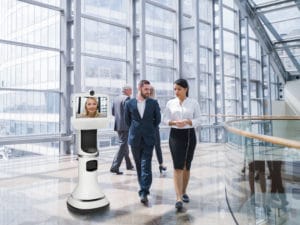
The Ava Telepresence robot allows potential buyers to “teleport” to real estate sites regardless of their physical location. Image courtesy of Ava Robotics
When the world went into quarantine last year, businesses shut down, consumers retreated to their homes and industries were forced to pivot only months into the new year just to survive.
Industries that rely on in-person business transactions, like the real estate industry, were hit especially hard. They could no longer host property tours or highlight amenities in person. This inability to run business as usual demanded innovation and integration in the real estate industry.
The Case for Telepresence
Adoption of robotics technologies has accelerated, becoming an increasingly popular way for businesses to solve both physical and digital challenges in the workplace.
Telepresence robots welcome employees, customers and clients to workplaces and enable remote users to collaborate effectively across teams. Remote users easily and safely navigate a variety of workplace settings, benefitting from a more real-feel, personalized experience, while businesses benefit from improved employee productivity.
Austrian real estate company SIGNA and Cisco partner FRINK Advanced Services were faced with an unprecedented challenge: How could they get customers to experience their properties, digitally, as if the customers were physically there? A crucial piece missing in the puzzle of a well-rounded, digital customer experience was a real-time experience that allowed customers to autonomously explore a property in detail, not having to rely on pre-selected views and angles.
That’s where the idea of using a robot was born. Partnering with Ava Robotics, our Cambridge robotics technology company that designs and builds intelligent robots for the workplace, SIGNA was able to bring a fully digital, remote sales experience powered by Ava’s telepresence robots.
The Cisco Webex-enabled Ava Telepresence robot allows potential buyers to seamlessly “teleport” to various real estate sites regardless of their physical location. Customers can virtually walk through a space, see finishes and rooms and interact with their seller in ways not seen since the onset of the pandemic.
Offering them a walkthrough that lets them control their experience has resulted in more confident decisions and positive outcomes.
Keys to Success
To provide truly effective collaboration and an immersive experience for both remote users and those who are on-location, several critical capabilities, which distinguish true telepresence robots from video conferencing on wheels, must be supported.
Navigation and Mobility: The ability to navigate a workplace autonomously is critical to the user experience. Telepresence robots that provide advanced mapping capabilities and collision avoidance allow operators to navigate to desired locations efficiently and autonomously with ease. Operators are not required to know the exact layout of an oftentimes unfamiliar space. Also, on-site team members remain free from any manual headaches.
Ease of Use: Easy-to-use interfaces allow for more control and customization of the experience. Position adjustments such as sitting, standing, looking up or down and moving closer empower employees, customers and clients to feel physically present in the space and immersed in the experience.

Marcio Macedo
Video Quality: The experience for both the operator and those physically present depends on the quality of the video. Having a crystal-clear view of one’s surroundings and reliable audio can be the difference between seamless collaboration and feeling disconnected from the team. With Cisco Webex Video and device integration into the robot, Ava fully leverages the Cisco infrastructure for security, manageability and return on investment.
The digital customer experience is the future for workplaces both now and long after the pandemic. Within the real estate industry, telepresence robots have opened a world of opportunity for customers to experience any property in detail, not needing to rely upon pre-selected content.
Businesses are continually learning how to be smarter, more efficient and more conscious to strengthen their cultures and deliver better outcomes. Telepresence robots not only solve immediate business needs but play a crucial role in an evolving industry post-COVID.
Marcio Macedo is the co-founder and vice president of product at Cambridge-based Ava Robotics.






